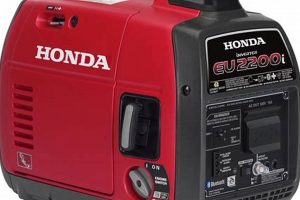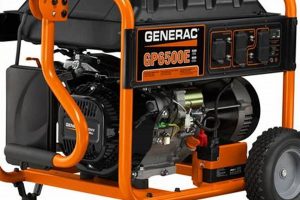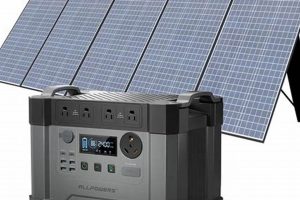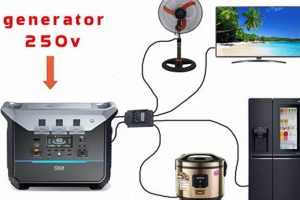Safe and effective power supply during outages requires a planned approach. This involves integrating a supplementary power source, such as a mobile electricity generator, with a dwelling’s electrical system. This integration typically necessitates a transfer switch, a device that isolates the house from the utility grid and safely connects it to the generator. This prevents backfeeding, a dangerous phenomenon where electricity flows back into the power lines, potentially harming utility workers.
Maintaining essential services during power disruptions offers significant advantages, from preserving food and comfort to powering vital medical equipment. Historically, homes lacked readily available backup power solutions. The advent of portable generators has provided a relatively affordable and accessible way to mitigate the impact of blackouts, offering homeowners increased resilience and peace of mind. This capability is increasingly important given the rising frequency of extreme weather events.
This article explores the intricacies of establishing a secure connection, encompassing topics such as transfer switch selection and installation, generator grounding, safety protocols, and relevant legal and regulatory considerations.
Safe Generator Integration Tips
Integrating a portable generator requires careful planning and execution to ensure safety and efficacy. The following tips provide essential guidance for proper setup and operation.
Tip 1: Consult a qualified electrician. Professional guidance is crucial for selecting the appropriate transfer switch and ensuring proper installation in compliance with local electrical codes. Incorrect installation can lead to hazardous conditions.
Tip 2: Select a properly sized generator. Generator capacity should match the power demands of essential appliances and equipment. An undersized generator may overload, while an oversized one wastes fuel.
Tip 3: Use a transfer switch. Direct connection to household circuits without a transfer switch is unsafe and illegal. Transfer switches prevent backfeeding and isolate the home’s electrical system from the utility grid.
Tip 4: Ground the generator correctly. Proper grounding protects against electrical shock. Consult the generator’s owner’s manual and local electrical codes for grounding requirements.
Tip 5: Operate the generator outdoors in a well-ventilated area. Generators produce carbon monoxide, a colorless, odorless, and deadly gas. Never operate a generator indoors or in enclosed spaces.
Tip 6: Allow the generator to cool before refueling. Hot engine components and spilled fuel can ignite. Always turn off the generator and let it cool completely before adding fuel.
Tip 7: Store fuel safely. Store fuel in approved containers in a well-ventilated area away from ignition sources.
Adhering to these safety precautions ensures reliable backup power during outages while safeguarding against potential hazards. Correct installation and operation contribute to long-term generator performance and prevent electrical risks.
By understanding these essential steps, homeowners can create a resilient power solution for emergencies and maintain the safety and well-being of their households.
1. Transfer Switch
Safe and compliant integration of a portable generator necessitates a transfer switch. This device acts as the crucial link, managing the flow of electricity and ensuring safety during power outages. Understanding its function and various types is paramount for effective generator integration.
- Preventing Backfeeding
A primary function of the transfer switch is preventing backfeeding, a hazardous condition where generator power flows back into the utility grid. This poses significant risks to utility workers and can damage equipment. The transfer switch isolates the house from the grid during generator operation, eliminating this danger.
- Types of Transfer Switches
Transfer switches come in various configurations, including manual and automatic. Manual switches require physical interaction to switch between utility and generator power. Automatic transfer switches detect outages and activate the generator automatically, providing seamless power transition. Selection depends on individual needs and budget.
- Installation and Compliance
Proper installation by a qualified electrician is crucial for safety and code compliance. Local electrical codes dictate specific requirements for transfer switch installation. Incorrect installation can lead to hazards and invalidate insurance coverage. Professional installation ensures the system meets all applicable standards.
- Capacity and Circuit Selection
Transfer switches are rated for specific amperage and voltage. The selected switch must match the generator’s output and the electrical load of the circuits it will power. Careful planning and consultation with an electrician ensures proper sizing and circuit selection for optimal performance and safety.
The transfer switch is an integral component in safely connecting a portable generator. Its proper selection, installation, and operation are essential for safeguarding both the household and utility workers. Understanding its role and various facets ensures a reliable and code-compliant backup power solution.
2. Proper Sizing
Effective integration of a portable generator hinges on accurate power assessment and generator selection. Proper sizing ensures the generator can handle the anticipated electrical load during an outage, preventing overload and ensuring reliable power delivery. Undersizing leads to inadequate power supply and potential generator damage, while oversizing results in unnecessary fuel consumption and higher operating costs.
- Load Calculation
Determining the required generator capacity necessitates calculating the wattage of essential appliances and devices. This involves adding the wattage of each item planned for simultaneous use during an outage. Online calculators and professional electricians can assist with accurate load assessments. An accurate calculation forms the basis of appropriate generator selection.
- Starting Watts vs. Running Watts
Electrical devices often require higher wattage during startup than during continuous operation. Generators are rated for both starting watts (surge wattage) and running watts (rated wattage). The chosen generator’s starting watts must accommodate the highest surge demand of any connected appliance to prevent overloading during startup. Ignoring this distinction can lead to tripped breakers and generator failure.
- Future Expansion Considerations
Anticipating future power needs is crucial during generator selection. If additional appliances or equipment are likely to be added later, selecting a generator with slightly higher capacity than currently required can avoid premature obsolescence and costly upgrades. This forward-thinking approach ensures long-term power sufficiency.
- Efficiency and Fuel Consumption
Generator efficiency directly impacts fuel consumption and operating costs. Operating a generator significantly below its rated capacity reduces efficiency and wastes fuel. Proper sizing optimizes fuel efficiency and minimizes environmental impact. Choosing a generator that aligns with the calculated load ensures efficient and cost-effective operation.
Proper generator sizing is fundamental to successful integration and reliable backup power. Accurate load calculation, consideration of starting and running watts, and anticipating future needs ensure the chosen generator meets the specific power demands of the household, optimizing efficiency and preventing potential issues. A correctly sized generator provides peace of mind during outages and ensures a safe and dependable power supply.
3. Safe Operation
Safe operation is paramount when connecting a portable generator to a house. Improper practices can lead to severe consequences, including carbon monoxide poisoning, fire hazards, and electrical shock. Understanding and adhering to safety protocols is crucial for protecting individuals and property. A comprehensive approach to safe operation encompasses ventilation, fuel handling, grounding, and connection procedures.
Generators produce carbon monoxide, a colorless, odorless, and lethal gas. Operating a generator in an enclosed space, such as a garage or basement, can rapidly lead to dangerous carbon monoxide buildup. Fatal incidents have resulted from inadequate ventilation during generator operation. Positioning the generator outdoors, away from windows and doors, ensures proper ventilation and mitigates this risk. Furthermore, allowing the generator to cool completely before refueling prevents accidental ignition of spilled fuel. Hot engine components can ignite fuel vapors, causing severe burns or fire. Storing fuel in approved containers, away from ignition sources, further reduces fire hazards. Correct grounding procedures are essential to prevent electrical shock. A properly grounded generator provides a safe path for stray electrical currents, minimizing the risk of shock during operation. Connecting the generator to the house electrical system through a properly installed transfer switch ensures safe and compliant operation. Direct connection to household circuits bypasses safety features and poses significant risks.
Safe operation encompasses a range of practices essential for mitigating risks associated with portable generator use. Adhering to these guidelines, including proper ventilation, fuel handling, grounding, and connection procedures, ensures the well-being of individuals and safeguards property. Neglecting these precautions can have dire consequences. Prioritizing safety through informed operation transforms a portable generator from a potential hazard into a reliable and secure power source during outages.
4. Legal Compliance
Connecting a portable generator to a house requires adherence to legal and regulatory requirements. Compliance ensures the safety of individuals, protects utility workers, and maintains the integrity of the electrical grid. Ignoring these regulations can result in penalties, invalidate insurance coverage, and create hazardous conditions. Understanding and complying with applicable codes and standards is essential for responsible generator integration.
- Permitting Requirements
Local jurisdictions often require permits for installing transfer switches and connecting generators to a house. Permitting processes ensure installations meet safety standards and comply with local electrical codes. Failure to obtain necessary permits can result in fines and legal complications. Consulting with local authorities clarifies permitting requirements and ensures compliance.
- Electrical Codes and Standards
Adherence to national and local electrical codes is crucial for safe generator integration. Codes dictate wiring specifications, grounding requirements, and transfer switch installation procedures. Compliance with these standards minimizes risks and ensures the safety of the electrical system. Professional electricians possess the knowledge and expertise to ensure installations meet all applicable codes.
- Interconnection Agreements with Utility Companies
Some utility companies require interconnection agreements for generators connected to the grid. These agreements outline technical requirements and operational procedures to ensure the safe integration of distributed generation. Non-compliance can disrupt grid stability and pose safety hazards. Contacting the local utility company clarifies interconnection requirements and facilitates compliance.
- Homeowners Association (HOA) Regulations
Some homeowners associations have regulations governing generator installation and operation. These regulations may address noise levels, placement restrictions, and aesthetic considerations. Compliance with HOA rules maintains community harmony and avoids potential disputes. Reviewing HOA guidelines before installation ensures compliance and avoids potential conflicts.
Legal compliance forms an integral part of responsible generator integration. Adhering to permitting requirements, electrical codes, interconnection agreements, and HOA regulations ensures the safety and legality of the installation. Compliance not only mitigates risks but also fosters a sense of responsibility towards the community and the electrical grid. Ignoring these legal aspects can lead to serious consequences, jeopardizing safety and incurring penalties. A comprehensive understanding of legal compliance transforms generator integration into a responsible and secure endeavor.
5. Professional Installation
Professional installation is paramount when connecting a portable generator to a house. This specialized service ensures the safety, code compliance, and long-term reliability of the backup power system. Attempting a DIY installation without adequate electrical expertise can lead to hazardous conditions, violate electrical codes, and potentially void insurance coverage. Professional electricians possess the knowledge and experience to navigate the complexities of generator integration, guaranteeing a safe and compliant setup.
A professionally installed system mitigates several critical risks. Incorrect wiring can lead to fires, electrocution, and damage to appliances. Improper grounding increases the risk of electrical shock. An incorrectly sized or installed transfer switch can cause backfeeding, endangering utility workers and damaging equipment. For instance, a homeowner attempting to connect a generator directly to a wall outlet without a transfer switch risks electrocution and severe damage to the electrical system. Professional installers understand the specific requirements for transfer switch selection, placement, and wiring, ensuring the system meets all applicable codes and safety standards. They also possess the expertise to calculate the appropriate generator size based on the home’s electrical load, preventing overloading and ensuring efficient operation.
Professional installation offers significant long-term benefits. A properly installed system reduces the risk of future electrical problems, ensuring reliable operation during outages. Compliance with electrical codes simplifies insurance claims related to power outages. Furthermore, professional installation adds value to the home by demonstrating a commitment to safety and quality. While the initial cost of professional installation may seem higher than a DIY approach, the long-term benefits of safety, compliance, and reliability far outweigh the upfront expense. A professionally installed generator connection provides homeowners with peace of mind, knowing their backup power system is safe, efficient, and compliant with all applicable regulations.
6. Regular Maintenance
A portable generator, while offering invaluable backup power, requires consistent maintenance for reliable and safe operation. Neglecting routine upkeep can lead to performance degradation, reduced lifespan, and potential safety hazards. Regular maintenance ensures the generator remains functional during critical power outages and safeguards against unexpected failures. Connecting a portable generator to a house, therefore, necessitates a commitment to ongoing maintenance as an integral part of the integration process.
- Oil Changes
Regular oil changes are fundamental to engine health and longevity. Engine oil lubricates moving parts, reducing friction and wear. Over time, oil degrades, losing its lubricating properties and accumulating contaminants. Failing to change the oil as recommended in the generator’s owner’s manual can lead to increased engine wear, overheating, and ultimately, engine failure. An example of this is a generator failing to start during a power outage due to thickened, contaminated oil. Regular oil changes ensure the generator starts reliably when needed.
- Air Filter Maintenance
Clean air filters are essential for optimal engine performance. The air filter prevents dust, debris, and other airborne particles from entering the engine. A clogged air filter restricts airflow, reducing combustion efficiency and leading to decreased power output and increased fuel consumption. For instance, a generator struggling to power essential appliances during an outage may have a clogged air filter. Regularly cleaning or replacing the air filter ensures sufficient airflow for optimal engine performance.
- Fuel System Inspection
Periodic inspection of the fuel system prevents fuel-related issues that can hinder generator operation. Checking for fuel leaks, stale fuel, and clogged fuel lines ensures a consistent fuel supply to the engine. Stale fuel can cause starting problems and damage the fuel system. For example, a generator failing to start after a period of storage may have stale fuel in the tank or carburetor. Draining stale fuel and refilling with fresh fuel before extended storage periods prevents such issues.
- Spark Plug Replacement
Spark plugs ignite the fuel-air mixture in the engine. Worn-out spark plugs can cause misfires, reduced power, and difficulty starting. Regularly replacing spark plugs according to the manufacturer’s recommendations ensures reliable ignition and efficient engine operation. For example, a generator experiencing intermittent power output during operation may have worn spark plugs that need replacing. Maintaining functional spark plugs ensures consistent power delivery during outages.
These maintenance practices ensure the long-term reliability and safety of a portable generator connected to a house. Regular upkeep minimizes the risk of unexpected failures during power outages, providing consistent and reliable backup power when needed most. Integrating a portable generator with a house requires not only proper installation but also a commitment to ongoing maintenance to maximize its effectiveness and lifespan. A well-maintained generator provides peace of mind during emergencies and safeguards against the disruption and inconvenience of power loss.
Frequently Asked Questions
This section addresses common inquiries regarding safe and effective portable generator integration with home electrical systems.
Question 1: Is professional installation necessary for connecting a portable generator?
Professional installation is strongly recommended. Qualified electricians ensure adherence to safety codes, proper transfer switch integration, and correct grounding, minimizing risks and ensuring compliance.
Question 2: What size generator is needed to power a typical house?
Generator sizing depends on the specific electrical load. Calculating the wattage of essential appliances and devices determines the required generator capacity. Professional electricians can assist with accurate load assessments.
Question 3: Can a portable generator be connected directly to a wall outlet?
Direct connection to wall outlets is unsafe and illegal. This practice, known as backfeeding, can energize power lines, posing lethal dangers to utility workers. A transfer switch is essential for safe connection.
Question 4: What safety precautions are essential during generator operation?
Generators produce carbon monoxide, requiring operation in well-ventilated outdoor areas. Allowing the generator to cool before refueling and storing fuel safely are crucial safety measures.
Question 5: Are there legal requirements for connecting a generator to a house?
Local electrical codes and permitting requirements often apply to generator installations. Consulting local authorities and qualified electricians ensures compliance and safe integration.
Question 6: How frequently should a portable generator be maintained?
Regular maintenance, as outlined in the owner’s manual, ensures reliable operation. This includes oil changes, air filter cleaning or replacement, fuel system inspection, and spark plug replacement.
Safe generator integration requires careful planning, professional guidance, and adherence to safety regulations. Understanding these aspects ensures a reliable and secure backup power solution for emergencies.
For further information and guidance, consult certified electricians and local authorities. Professional expertise ensures compliance with regulations and safeguards against potential hazards.
Connecting a Portable Generator to a House
Safe and effective integration of a portable generator with a home’s electrical system requires careful planning, meticulous execution, and adherence to safety regulations. This comprehensive exploration has highlighted the critical aspects of proper connection, emphasizing the importance of transfer switches, correct sizing, safe operation, legal compliance, professional installation, and regular maintenance. Each component plays a vital role in ensuring a reliable and secure backup power solution while mitigating potential hazards.
Reliable backup power provides essential support during outages, safeguarding households and ensuring continuity of critical services. Investing in a properly integrated portable generator offers significant long-term benefits, enhancing resilience and peace of mind. However, realizing these benefits necessitates a commitment to informed decision-making, professional guidance, and responsible operation. Safeguarding a home requires not only the provision of backup power but also a dedication to the safe and compliant integration of this essential resource.






